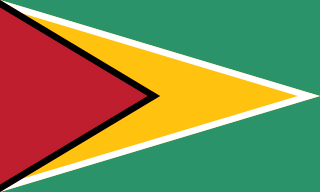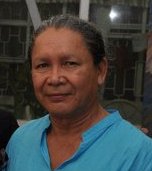Related Research Articles

The Arawak are a group of Indigenous peoples of northern South America and of the Caribbean. Specifically, the term "Arawak" has been applied at various times from the Lokono of South America to the Taíno, who lived in the Greater Antilles and northern Lesser Antilles in the Caribbean. All these groups spoke related Arawakan languages.
Guyanese culture reflects the influence of African, Indian, Amerindian, British, Portuguese, Chinese, Creole, and Dutch cultures. Guyana is part of the mainland Caribbean region. Guyanese culture shares a continuum with the cultures of islands in the West Indies.
Guyanese literature covers works including novels, poetry, plays and others written by people born or strongly-affiliated with Guyana. Formerly British Guiana, British language and style has an enduring impact on the writings from Guyana, which are done in English language and utilizing Guyanese Creole. Emigration has contributed to a large body of work relating the Guyanese diaspora experience.
Roy Aubrey Kelvin Heath was a Guyanese writer who settled in the UK, where he lived for five decades, working as a schoolteacher as well as writing. His 1978 novel The Murderer won the Guardian Fiction Prize. He went on to become more noted for his "Georgetown Trilogy" of novels, consisting of From the Heat of the Day (1979), One Generation (1980), and Genetha (1981), which were also published in an omnibus volume as The Armstrong Trilogy, 1994. Heath said that his writing was "intended to be a dramatic chronicle of twentieth-century Guyana".
The Arawak village of Wakapau (or Wakapoa) is located in the Pomeroon-Supenaam Region of Guyana, on the Wakapau River, a tributary on the west bank of the Pomeroon River, 3 kilometres (1.9 mi) from its mouth. The name originates from the Lokono word ‘Wakokwãn’, which means pigeon. The village is composed of twenty inhabited islands. Some of the islands only contain a single family.

Edgar Austin Mittelholzer was a Guyanese novelist. He is the earliest professional novelist from the English-speaking Caribbean. He was able to develop a readership in Europe and North America, as well as the Caribbean; and established himself in London, where he lived almost exclusively by writing fiction. He is considered "the most prolific novelist to be produced by the Caribbean".
Michael Arthur Gilkes was a Caribbean literary critic, dramatist, poet, filmmaker and university lecturer. He was involved in theatre for more than 40 years, as a director, actor and playwright, winning the Guyana Prize for Drama in 1992 and 2006, as well as the Guyana Prize for Best Book of Poetry in 2002. He was also respected for his insight into and writings on the work of Wilson Harris.
Stanley Greaves is a Guyanese painter and writer who is one of the Caribbean's most distinguished artists. Writing in 1995 at the time of a retrospective exhibition to celebrate Greaves's 60th birthday, Rupert Roopnarine stated: "It may be that no major Caribbean artist of our time has been more fecund and versatile than Stanley Greaves of Guyana." Greaves himself has said of his own creativity:
I still don't talk about myself as making art! Other people do that. I am a maker of things. In the early days, I found empty matchboxes, cigarette boxes, bits of string, wire, empty boot-polish tins, whatever, and made things. Drawing was just another activity, and it still is. My favorite medium is still wood, of course. My hitherto secret preoccupation with writing poems, which has now come to light, is another form of making. Recently at the University of Birmingham, where I did a reading, I was asked if the paintings influenced the poetry, and I said, "No, they come from the same source."
Aubrey Williams was a Guyanese artist. He was best known for his large, oil-on-canvas paintings, which combine elements of abstract expressionism with forms, images and symbols inspired by the pre-Columbian art of indigenous peoples of the Americas.

The people of Guyana, or Guyanese, come from a wide array of backgrounds and cultures including aboriginal natives, African and Indian origins, as well as a minority of Chinese and European descendant peoples. Demographics as of 2012 are Indo-Guyanese 39.8%, Afro-Guyanese 30.1%, mixed race 19.9%, Amerindian 10.5%, other 1.5%. As a result, Guyanese do not equate their nationality with race and ethnicity, but with citizenship. Although citizens make up the majority of Guyanese, there is a substantial number of Guyanese expatriates, dual citizens and descendants living worldwide, chiefly elsewhere in the Anglosphere.

George Simon was a Guyanese Lokono Arawak artist and archaeologist. He was the founder and mentor of the Lokono Artists Group, a group of Lokono artists from Guyana, based primarily in his hometown of St. Cuthbert's Mission. Simon was widely regarded as one of the leading Guyanese artists of his generation, and his paintings are notable for their explorations of Amerindian culture and the Guyanese environment. He was also recognized for his achievements as an educator, his efforts to develop opportunities for Amerindian artists in Guyana, and for his work as an archaeologist.
John Peter Bennett was a Guyanese priest and linguist. A Lokono, in 1949, he was the first Amerindian in Guyana to be ordained as an Anglican priest and canon. His linguistic work centred on preserving his native Arawak language and other Amerindian languages; he wrote An Arawak-English Dictionary (1989).

Donald Cuthbert Locke was a Guyanese artist who created drawings, paintings and sculptures in a variety of media. He studied in the United Kingdom, and worked in Guyana and the United Kingdom before moving to the United States in 1979. He spent his last twenty years, perhaps the most productive and innovative period of his life, in Atlanta, Georgia. His eldest son is British sculptor Hew Locke.
Edward Rupert Burrowes was a Guyanese artist and art teacher who founded the Working People's Art Class (WPAC), the first established art institution in Guyana. The E R Burrowes School of Art, an undergraduate institution accredited by the University of Guyana, is named after him.
The Working People's Art Class (WPAC), founded by Edward Rupert Burrowes in 1945, was the first established art institution in the colony of British Guiana, now the country of Guyana. A number of well-known Guyanese artists were taught at the WPAC.
St. Cuthbert's Mission is an Amerindian village on the Mahaica River in the Demerara-Mahaica region of Guyana. It comprises approximately 200 households. St. Cuthbert's is regarded by many people in Guyana as the "cultural capital" for Amerindians.
Castellani House is a large nineteenth-century building in Georgetown, Guyana. It is on the corner of Vlissengen Road and Homestretch Avenue. It was designed and constructed by the Maltese architect, Cesar Castellani, between 1879 and 1882. Originally serving as a residence for colonial government officials, Castellani House has been the home of Guyana's National Art Gallery since 1993.

The Olmec-Maya and Now (1981–1985) is a series of large, oil-on-canvas paintings by Aubrey Williams. The series grew out of Williams' enduring interest in pre-Columbian cultures of the indigenous peoples of the Americas. It explores parallels between Olmec and Maya civilizations and contemporary global culture, focusing in particular on the threat of rapid demise and self-destruction.

Indigenous peoples in Guyana, Native Guyanese or Amerindian Guyanese are Guyanese people who are of indigenous ancestry. They comprise approximately 9.16% of Guyana's population. Amerindians are credited with the invention of the canoe, as well as Cassava-based dishes and Guyanese pepperpot, the national dish of Guyana. Amerindian languages have also been incorporated in the lexicon of Guyanese Creole.
Anne Walmsley is a British-born editor, scholar, critic and author, notable as a specialist in Caribbean art and literature, whose career spans five decades. She is widely recognised for her work as Longman's Caribbean publisher, and for Caribbean books that she authored and edited. Her pioneering school anthology, The Sun's Eye: West Indian Writing for Young Readers (1968), drew on her use of local literary material while teaching in Jamaica. A participant in and chronicler of the Caribbean Artists Movement, Walmsley is also the author of The Caribbean Artists Movement: A Literary and Cultural History, 1966–1971 (1992) and Art in the Caribbean (2010). She lives in London.
References
- 1 2 3 4 5 6 7 Walmsley, Anne; Stanley Greaves (2010). "Oswald Hussein: Oriyu Banka (Bench of the Water Spirit)". Art in the Caribbean: An Introduction. London: New Beacon Books. pp. 56–7. ISBN 9781873201220.
- 1 2 3 4 5 6 Anon (21 October 2007). "Arts on Sunday". Stabroek News. Retrieved 8 September 2012.
- ↑ Creighton, Al (3 June 2007). "The artistic contribution to a national identity". Stabroek News. Retrieved 8 September 2012.
- ↑ Creighton, Al (5 September 2010a). "The Arts and the Environment". Stabroek News. Retrieved 14 August 2012.
- 1 2 3 4 Twedell, Louise (3 October 2006). "Sculptor's trip shaped by fate". This Is London. Retrieved 8 September 2012.
- ↑ Simon, George; Anne Walmsley (December 1995). "Art Looking Inland: George Simon Talks to Anne Walmsley". Kyk-Over-Al. 46/47: 67–76 [68]. Retrieved 14 August 2012.
- 1 2 Hosein, Alim (29 September 2002). "Moving Circle" (Archive copy of original article). Stabroek News. Retrieved 16 August 2012.
- ↑ Creighton, Al (31 October 2010b). "The Rise of Amerindian Art". Stabroek News. Retrieved 16 August 2012.
- ↑ Walmsley, Anne; Stanley Greaves (2010). "Time Line 5000BC-AD2010". Art in the Caribbean: An Introduction. London: New Beacon Books. pp. 158–172 [169]. ISBN 978-1-873201-22-0.
- 1 2 Hosein, Alim (30 September 2001). "The new Amerindian force in Guyanese art: Sunset Birds III". Stabroek News. Retrieved 16 August 2012.
- 1 2 Alivizatou, Marilena (2012). "Reinventing the Gift at the Horniman Museum". Intangible Heritage and the Museum: New Perspectives on Cultural Preservation. Walnut Creek: Left Coast Press. pp. 135–159 [153]. ISBN 9781611321517.
- 1 2 Smith, Kate (26 September 2006). "Arawak Artist in Residence at the Horniman Museum". Culture24. Retrieved 8 September 2012.
- ↑ Anon (22 August 2006). "Visiting Artist from Guyana". EthnicNow. Retrieved 8 September 2012.
- ↑ Watson, Anthony (August 2005). "Press Release" (PDF). Horniman Museum. Retrieved 8 September 2012.